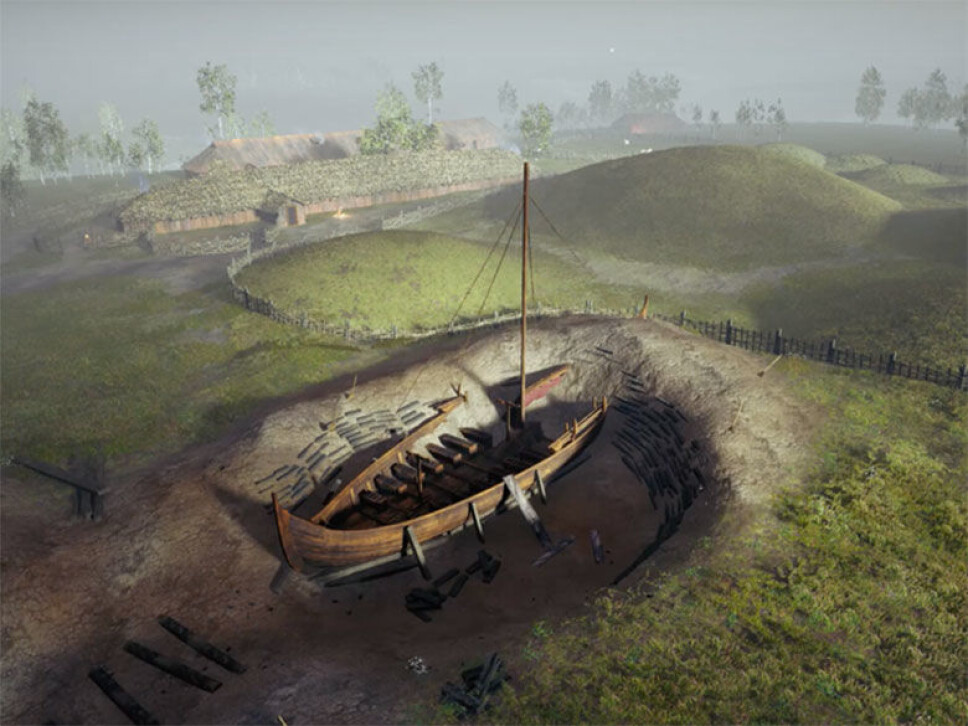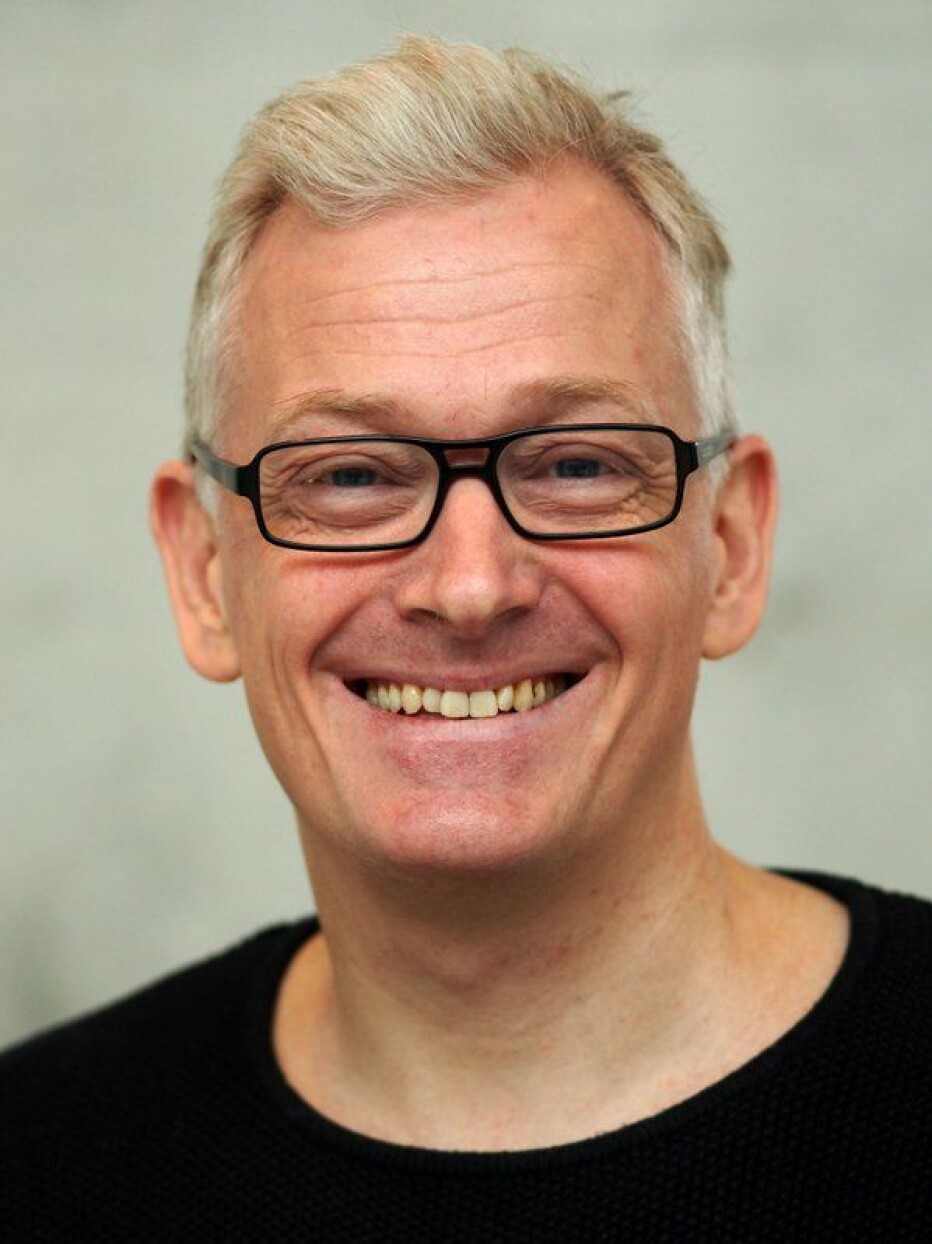This article is produced and financed by the Østfold University College - read more

The viking ship at Gjellestad comes to life online
A Viking ship and old settlements which were discovered at Gjellestad outside Halden in 2018 have now been brought to life by researchers from Østfold University College. The digital grave site is based on archaeological findings and historical research.
“Imagine that you’re flying in towards Gjellestad and discover the large burial mound, longhouses and boat grave", says Joakim Karlsen.
"You can choose to come closer and move around the houses and of course the ship, and explore the site to gain insights into what the archaeologists have found so far.”
Associate Professor Joakim Karlsen from Østfold University College’s IT department, who researches digital storytelling, is the project manager of the digitalisation of the Gjellestad ship.
During the autumn of 2019, sections of the Viking ship, five longhouses and eight burial sites were discovered during the excavations close to Jellehaug, which can be seen from the E6 highway outside Halden in Norway.
“It was very challenging to build a comprehensive visual representation of the findings at Gjellestad based on the data the archaeologists currently have available,” explains Karlsen.
He says they were dependent on close collaboration with the archaeologists during the project in order to make sure that they could make informed guesses based on current research for the areas where the data is not definite.
“But there was little disagreement over the details and the choices made along the way, as the archaeologists were good at explaining why the ship, houses and site had to look the way they do in the final rendering.”

Showing developments from the Bronze Age to the Viking Age
Karlsen says part of what made this project so challenging and exciting was that the visualization was created in tandem with the excavation work. There were several rounds where 3D elements had to be removed, added and altered in accordance with ongoing feedback from the archaeologists. This was quite costly, as construction in 3D is time-consuming work.
Østfold County Council allocated the funds that allowed researchers from Østfold University College and the Institute for Energy Technology to recreate Gjellestad digitally.
They have recreated the Viking ship, its burial mound, the houses and the landscape around the burial mounds online to allow visitors to get a realistic visualization of the research and findings from the Viking ship grave and its surroundings.
Viking ship tiller trouble
Despite the fact that they went through many rounds of revisions and improvements, a rather large error slipped through as the project was close to completion.
“The tiller on the Viking ship turned out to have been placed at the front of the ship during the intro animation and on the ship’s left side in the burial mound. The error was discovered after publication, and had to be corrected. Neither our team, the archaeologists, nor the other contributors to the project could live with a misplaced tiller after having spent so much time on making the visualization as accurate as possible.”
The potential to bring new life to forgotten cultural heritage sites
Karlsen hopes people will take the time to experience the visualization that brings Gjellestad to life online.
Not only will the audience learn more about Viking graves and longhouses, they will also get a rare demonstration of how archaeologists work to gain new knowledge from fragments and traces in the ground.
“It will be very exciting to follow the process as it moves forward. We hope we will have the opportunity to update this visualization as new data and insights become available. This project demonstrates the potential that 3D visualization has for displaying information about cultural heritage sites and artefacts that are not accessible or visible to the eye. We can now capture this information and display it using new techniques and methods in digital archaeology,” he says.
The research behind the digitisation of Gjellestad aims to further develop methods, techniques and tools in support of interdisciplinary work in creating and sharing digital resources related to vulnerable cultural heritage sites such as Gjellestad.
“The Gjellestad excavations represent a perfect case study, where the processes of capturing, systematizing, interpreting and disseminating the data from the discovery can be understood and supported,” says Karlsen.

Start your journey
You can experience for yourself the archaeological discoveries from Gjellestad at gjellestadstory.no.
References:
Skipsgraven fra Gjellestad – ny viten om datering og bevaringstilstand (the Gjellestad Viking ship grave – new insights on how old it is and its state of preservation). Informative article om the Viken county municipality website, January 2020.
Vikingskipsfunn i Østfold (Viking ship discovery in Østfold). Press release from NIKU and Østfold county municipality, 2019.
Overview page with articles about the Gjellestad ship by NIKU (the Norwegian Institute for Cultural Heritage Research).
Dette vet vi om Gjellestadskipet nå (This is what we currently know about the Gjellestad ship). Article on the website of the Museum of Cultural History at the University of Oslo, January 2020.
———
Read the Norwegian version of this article at forskning.no

This article is produced and financed by Østfold University College
Østfold University College is one of 77 owners of ScienceNorway.no. Its communication staff provide content to forskning.no. We label this content clearly to distinguish institutional outreach from independent editorial content. Read more about this arrangement here.
Read more about this arrangement here.






























